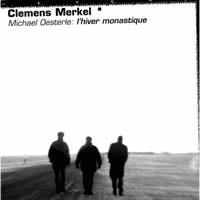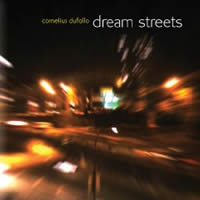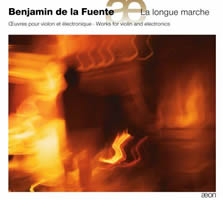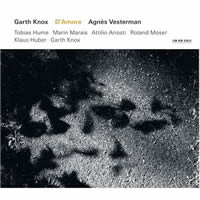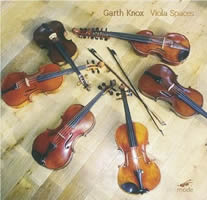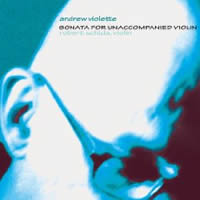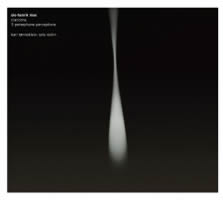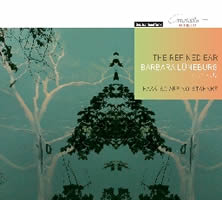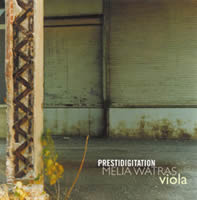String Theory 1: Violins and Violas
|
Grant Chu Covell [February 2010.]
Michael OESTERLE: l’hiver monastique (2000). Clemens Merkel (vln). Collection QB CQB 0703 (http://www.collectionqb.com/). Distributed in the US by CDeMusic (http://www.cdemusic.org/). This single-movement 75-minute span bears the subtitle, “70 consolations harmoniques pour violin.” In unceasing motion, Oesterle juggles 70 four-pitch groups into repeating patterns, generally double-stops with frequent harmonics, uneven rhythmic profiles and infrequent fast notes. The constant activity doesn’t paint a picture of winter, the monastic life or quiet contemplation. An hour-and-a-quarter of perpetual motion hints at a feeling of weariness. Merkel acquits himself marvelously. Oesterle, whom we met here, appears to favor muted timbres.
“Dream Streets.” Cornelius DUFALLO: Asst. comps. Cornelius Dufallo (vln, electronics). Innova 735 (http://www.innova.mu/). Distributed in the US by Naxos (http://www.naxos.com/). “La longue marche.” Benjamin de la FUENTE: Var. comps. (2007-08). Benjamin de la Fuente (vln, electronics). Aeon AECD 0980 (http://www.aeon.fr/). Distributed in the US by Allegro Music (http://www.allegro-music.com/). Improvisation isn’t a common component of violinists’ conservatory training; however, those who explore contemporary music are often exposed to its possibilities. On Dream Streets one of the ETHEL string quartet’s violinists steps forward for a solo turn. While I don’t expect every string player to perform on a Guadagnini, Dufallo’s strident instrument impinged on my enjoyment. Most of these pieces imply improvisation over loops: A gesture is fed into an electronic delay, post-minimalist noodling adds a second layer, and an overlay of a dreamy solo completes the picture. Dufallo tends towards a slurpy Lydian mode. Instead of through-composed codas he will sometimes take an easy fade into city-noise soundscapes. Some pieces, like the final Transcendence, flirt with the joy of delay. Otherwise, the electronics don’t enhance interesting material. De La Fuente’s violin cohabits with electronics in nine tracks on La longue marche. Despite effusive documentation, it’s unclear whether these pieces are the result of studio manipulation or can be played live via real-time electronics or as solo violin accompanied by tape. Even if improvisation was the impetus, with blues and non-European styles as influences, I never grasped a story or a reason for any of this music. The titles did not help. The violin and electronic sounds aren’t particularly striking. For the most part, the electronics serve as processing effects. The violin transforms into an electric guitar in the final Get rid of the shackles. Elsewhere concrète samples abound.
“D’Amore.” Garth KNOX: Malor me bat (2004)*. Marin MARAIS: Les Folies d’Espagne (1685, arr. Knox/Vesterman)*. Roland MOSER: Manners of Speaking (2006). Tobias HUME: A Pavin (1605, arr. Knox). Attilio ARIOSTI: Prima Lezione (1720)*. Klaus HUBER: …Plainte… (1990). Trad. tunes arr. for viola d’amore and vlc*. Garth Knox (viola d’amore), Agnès Vesterman* (vlc). ECM 1925 (http://www.ecmrecords.com/). “Viola Spaces.” Garth KNOX: Viola Spaces (eight concert studies) (2007)1; Viola Spaces Variations on Marin Marais (2007)2; La Valse de la Vineuse (2005)3; Jonah and the Whale (1996)4; Ockeghem Fantasy (2001)5. Garth Knox1, 2, 3, 4, 5 (vla, viola d’amore), Johannes Eva1, 2, 5, Julien Heichelbech1, 2, 5, Marie Petit1, 2, 5, Cyprien Busolini1, 5, Aurélien Grais1, 5 (vlas), Carol Robinson3 (clar), Nathalie Chabot3 (vln), Agnès Vesterman3 (vlc), Gérard Buquet4 (tuba). mode 207 (http://www.moderecords.com/). Since departing the Arditti Quartet in 1997, Knox has enjoyed a solo career on viola and viola d’amore. ECM contributes its characteristic reverberant atmosphere to Knox’s wide-ranging viola d’amore repertoire. The contemporary items, both by Swiss composers, Huber’s memorial to Luigi Nono and Moser’s two-part solo, leave the most lasting impression, perhaps because their subtle microtones and scordatura directly engage the instrument’s sympathetic strings (another Moser work appeared here). Knox’s own Malor me bat, perfectly suited for the seven playable strings, adds a booming cello that seems out of place. Perhaps a bass viol or even contrabass would have provided an ideal warmth and timbral contrast in the Marais and Ariosti. It would have been pleasant to hear Knox wandering about unaccompanied a bit more than what is offered. The frisky traditional tunes suggest a happy relationship with the viola d’amore. Mode assembled a grab-bag of Knox’s compositions. Named for a festival (mentioned here), the Viola Space etudes concentrate two, three or four violists on a specific technical issue, using, for example, one left-hand finger or bowing close to the bridge. The Viola Spaces Variations on Marin Marais employ each technique for eight variations on Marais’ La Folia. The extraordinarily colorful Jonah and the Whale pairs viola and tuba and asks both players to talk and make other noises by way of telling the story. The viola d’amore appears in La Valse de la Vineuse (with clarinet, violin and cello) and Ockeghem Fantasy (fivefold!). The latter piece traces its inspiration to Nono’s string quartet, Fragmente – Stille, An Diotima, which quotes Ockeghem, albeit obscurely.
Andrew VIOLETTE: Sonata for Unaccompanied Violin (2006). Robert Uchida (vln). Innova 711 (2 CDs) (http://www.innova.mu/). Distributed in the US by Naxos (http://www.naxos.com/). Sonata for Unaccompanied Violin occupies two discs. Violette would doubtless like to be counted among other “big piece” composers — Sorabji and Feldman come first to mind. This opus isn’t likely to get him there. Despite recurring material, its architecture lacks rigor. Two small opening movements, Aria and Bells, suggest Bach and Paganini, whereas the prosaic subsequent 34-minute Chaconne squashes any reverential notions. Where Bach’s solo chaconnes build, Violette generates a blizzard of notes. On disc two, seven Aria variations attempt historic relevance. Four variations allude to Ysaÿe, Kreisler, Bartók and Verdi, in each instance weakly. Perhaps the Kreisler variation works best because he often wrote in-the-style-of morceaux, passing them off as others’ work. Other variations overstay their welcome, a tedious The Aria Deconstructed Variation among them. Despite Uchida’s noble effort, at the end of the day — or night — the Sonata is simply witless and long. The first CD features the 59-page score and an analysis.
Ole-Henrik MOE: Ciaccona (2002); 3 Persephone Perceptions (1995-96). Kari Rønneklieiv (vln). Rune Grammofon RCD 2068 (2 CDs) (http://www.runegrammofon.com/). Distributed in the US by Forced Exposure (http://www.forcedexposure.com/). Going beyond even Xenakis and Lachenmann, Moe’s abrasions are best recommended to the courageous. He explores the violin’s harmonic and noise potential with heavy and light bow pressure, playing on the “wrong” side of the bridge, along with other non-standard techniques. In 14 tracks, Ciaccona’s variations behave vaguely like their Baroque predecessors, provoking screams. Forgetting that one is listening to a violin may make the experience more palatable. 3 Persephone Perceptions comprise three unequal parts. While I don’t mind extensive spans of partials sparked by noisy scratching, a return to traditional sonorities might make the monolithic structure easier to endure. The few contrasting moments are the best, e.g., the third of the Persephone Perceptions. There are neither track listings nor durations for either disc. Titles are barely visible on their white surfaces.
“The Refined Ear.” Georg Friedrich HAAS: …aus freier Lust…verbunden (1996); de terrae fine (2001). Salvatore SCIARRINO: 6 Capricci (1976). Manfred STAHNKE: Capra (1987). Barbara Lüneburg (vln, vla). Coviello Classics COV60610 (http://www.covielloclassics.de/). Distributed in the US by Qualiton (http://www.qualiton.com/). These solo string pieces — three for violin, one for viola — find new sonorities without resorting to tape or electronics. The track listing swaps instruments for the Haas works: …aus freier Lust…verbunden requires viola and de terrae fine is scored for violin. The viola work shares its title with several other pieces for diverse instruments which can be combined or played as solos. Quarter-tones thwart tonal goals as the soloist wanders through choppy melodies. Haas’ de terrae fine is the standout, a 20-minute expanse packed with microtones and unpredictable harmonies. Here again the soloist ambles continually, discovering fresh sonorities and material. Stahnke asks the strings be tuned down to F, C, F and C. Structured like a multi-movement suite, Capra’s looser string tension combined with folksy gestures creates a casual mood. Not just because his six caprices are closest chronologically to Paganini is Sciarrino in the unlikely position of standard bearer. Requiring fleet fingers, extensive harmonics and controlled ponticello, the caprices explore Sciarrino’s characteristically feathery and atmospheric world, suggesting troubled breathing or a clouded periphery.
“Prestidigitation.” Richard KARPEN: Aperture (2006). Juan PAMPIN: Nada (2006). Heinrich TAUBE: Tacoma Narrows (2006). Diane THOME: And Yet… (2006). Brent Michael DAVIDS: Viola Jokes (2005)*. Melia Watras (vla), William George* (ten). Fleur de Son FDS 57992 (http://www.fleurdeson.com/). Distributed in the US by Qualiton (http://www.qualiton.com/). Violist Watras steps away from the Corigliano Quartet for her second solo outing. Karpen’s Aperture adds real-time processing to the viola’s gestures. The opus traces a universal journey: A naïve opening leads to anger, thence to repose. A surprise coda hints at Mozart and Berlioz. Pampin’s Nada spreads atmosphere through long notes flung like javelins. These first two items use live electronic delays and effects. Unexpected flourishes and noises enliven the techniques’ essential soupiness. Tacoma Narrows and And Yet… employ pre-recorded sound. To be precise, the former says “tape,” the latter, “computer-realized sound.” Taube’s Tacoma Narrows refers to the famous bridge that shook itself to pieces. Accompanied by a computer-generated piano cascading through an untempered pentatonic scale, the viola wriggles and bounces acrobatically. Thome’s And Yet… combines swirling electronics with Brahmsian motives. It’s rather strange to hear the viola played traditionally. There’s an entire species of humor that lampoons violists, Davids’ Viola Jokes for viola and tenor representing but a tiny sample as a finish to a varied program.
Ariosti, D Thome, Davids, Dufallo, Fuente, Haas, Hume, K Huber, Kerpen, Knox, Marais, Moe, Moser, Oesterle, Pampin, Sciarrino, Stahnke, Taube, Violette
[More Grant Chu Covell, String Theory]
[More
Ariosti, D Thome, Davids, Dufallo, Fuente, Haas, Hume, K Huber, Kerpen, Knox, Marais, Moe, Moser, Oesterle, Pampin, Sciarrino, Stahnke, Taube, Violette]
[Previous Article:
The French Connection]
[Next Article:
Der kranke Pierrot]
|
